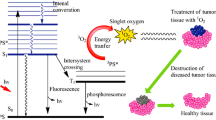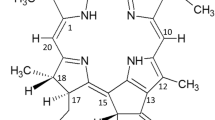Abstract
Due to the nontoxicity and efficient anti-cancer activity, more and more attention has been paid to N-glycoside compounds. Laser photolysis of N-(α-D-glucopyranoside) salicyloyl hydrazine (NGSH) has been performed for the first time. The research results show that NGSH has high photosensitivity and is vulnerable to be photo-ionized via a monophotonic process with a quantum yield of 0.02, generating NGSH+· and hydrated electrons. Under the aerobic condition of cells, the hydrated electrons are very easy to combine with oxygen to generate 1O2 and O2 −, both of which are powerful oxidants that can kill the cancer cells. In addition, NGSH+· can be changed into neutral radicals by deprotonation with a pK a value of 4.02 and its decay constant was determined to be 2.55×109dm3·mol−1·s−1. NGSH also can be oxidized by SO4 −· with a rate constant of 1.76×109 dm3·mol−1·s−1, which further confirms the results of photoionization. All of these results suggest that this new N-glycoside compound might be useful for cancer treatment.
Similar content being viewed by others
References
Sampathkumar S G, Jones M B, Meledeo M A. Targeting glycosylation pathways and the cell cycle: Sugar-dependent activity of butyrate-carbohydrate cancer prodrugs. Chem Biol, 2006, 13(12): 1265–1275
Nicolas B, Moulay B, Marie D L, Thierry M. One-pot stereoselective synthesis of β-N-aryl-glycosides by N-glycosylation of aromatic amines: One-pot stereoselective synthesis of β-N-aryl-glycosides by N-glycosylation of aromatic amines: Application to the synthesis of tumor-associated carbohydrate antigen building blocks. Tetrahedron, 2007, 63(19): 4178–4183
Sun X Y, Zhang C J, Wang M, Wang S L, Ni Y M, Yao S D. Laser flash photolysis and pulse radiolysis study on chemical activity of VP-16 and podophyllotoxin. Sci China Ser B-Chem, 2002, 45(2): 191–199
Wang S L, Yao S D, Zhang M W, Zhang Z C, Jiang Y. Oxidizing mechanism of podophyllotoxin and its derivatives by sodium persulfate. Sci China Ser B-Chem, 1996, 39(4): 425–432
Wang S L, Sun X Y, Zhang C J, Wang M, Li W Z, Liu S H, Ni Y M, Yao S D. Antitumor mechanism of VP-16: A pulse radiolysis study. Sci China Ser B-Chem, 2002, 45(4): 394–397
Lu C Y, Wang W F, Lin W Z, Han Z H, Pan J X, Yao S D, Lin N Y. Monophotonic ionization of etoposide in aqueous solution by 248 nm laser light: Identification of transient intermediates. J Photochem Photobiol Ser B-Biol, 1999, 49: 61–64
Lu C Y, Han Z H, Cai X C, Chen Y L, Yao S D. Photophysical and photochemical processes of riboflavin (vitamin B2) by means of the transient absorption spectra in aqueous solution. Sci China Ser B-Chem, 2001, 44(1): 39–48
Hart E J, Anbar M, The Hydrated Electron. New York: Wiley, 1970. 38–40
Magorzata W, Eberhard B, Helmut G, Dietrich S F. Quantum yields for the generation of hydrated electrons and single-strand breaks in poly(C), poly(A) and single-stranded DNA in aqueous solution on 20 ns laser excitation at 248 nm. Photochem Photobiol Ser A-Chem, 1990, 53(1): 87–108
Author information
Authors and Affiliations
Corresponding author
Additional information
The same contribution to the work
Supported by the National Natural Science Foundation of China (Grant Nos. 30570376 and 50673078) and Shanghai Project (Grant Nos. 06JC14068 and 08ZZ21)
Rights and permissions
About this article
Cite this article
Zhao, P., Wang, M., Zhang, S. et al. Photochemical properties of a new kind of anti-cancer drug: N-glycoside compound. Sci. China Ser. B-Chem. 51, 872–877 (2008). https://doi.org/10.1007/s11426-008-0091-7
Received:
Accepted:
Published:
Issue Date:
DOI: https://doi.org/10.1007/s11426-008-0091-7




